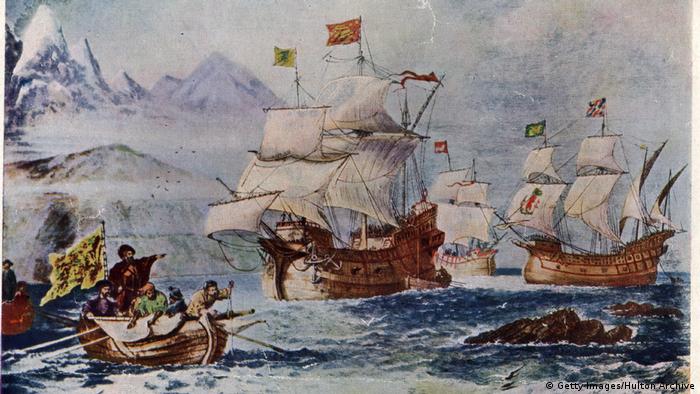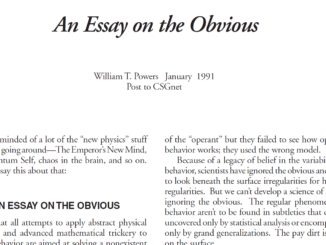Martin Taylor

Note: This salute to William T. Powers, the creator of Perceptual Control Theory (PCT), was posted to the CSGNet discussion list by Martin Taylor on September 15, 2016 and is posted here with his permission.
In the early 1500’s the “Spice Islands” (in the region around Indonesia and Malaysia) were a part of the world reached from Europe by a long and arduous passage past the Cape of Good Hope and India. Because their spices fetched huge sums of money in Europe, European maritime powers contested to colonize them and monopolize their particular products.
Columbus had hoped to reach them by travelling west, but had been blocked by the Americas. Within fifteen years of Columbus’s first voyage of discovery, Amerigo Vespucci had shown South America to be a large land mass blocking further westward travel, and Henry VIII of England had sent John Cabot to try to find a way west around North America.
In 1520, less than thirty years after Columbus, Ferdinand Magellan found a passage a long way south along the South American coast, and that passage opened onto a vast ocean, an ocean that was not unknown, but that until then could be reached from Europe only by the eastward route or overland across Mexico or Central America. In early 1521, Magellan reached the Philippines having discovered a couple of Pacific islands on the way, but was killed there. Eventually a few of the original crew arrived home, having completed the first circumnavigation of the Earth.
What the small remaining crew brought home was the news that a way existed to get to the Spice Islands westward by sea. There would be a map of the narrow and difficult strait, and maps of a few islands new to European knowledge, including the Philippines. To European eyes, the Pacific world now contained more than the Spice Islands. The way was open to them and the rest of the broad Pacific from Europe by sea.
But was the way open? Even now, with modern technology and power, it is not easy to use the Strait of Magellan, especially against the prevailing Westerly winds. It took a long time to map the Pacific. Even 200 years after Magellan Baja California was an island, Australia was not known to be an island and it took another 50 years before a European saw its east coast. Magellan’s maps would have been far from charting all the details even of the passage that is now named after him.
What has this to do with Powers? I think there are several analogies worth thinking about. Let’s think about the Spice Islands, a rich region that grew spices that fetched huge sums of money back in Europe. It was a region much coveted and fought over by European colonial powers. I think of this and the rest of the riches of the Pacific as analogous to Psychology, much fought over by different schools that are all based on the same underlying concept, the “Eastward” or “unidirectional” concept, which we now oppose to the “Westward” or “negative feedback” concept.
Just as Magellan opened an entirely new way to approach those islands, Powers opened up a new way to approach Psychology. Just as Magellan mapped the Strait in gross detail, so Powers mapped his entryway in gross detail. Just as Magellan’s maps did not list every rock and shoal in his strait, so Powers acknowledged that there were many uncertainties yet to be explored within the gross structure of his control hierarchy.
Just as Magellan found a few islands in the Pacific unknown to European commerce, so Powers found a few aspects of psychology not known to those who approached it from the other direction. And just as the maps Magellan made were guides for later explorers, so the guidance Powers offered to those who would follow his footsteps helped and continues to help later explorers.
There’s another parallel, as well, which is that although Magellan’s maps showed the way for ships to sail from the Atlantic into the Pacific, the route was never easy for wooden sailing ships; it is not so easy even for modern powered ships with GPS, radar, and other technologies. Likewise, Powers’ map of the possibilities of control hierarchies is not easy for others to follow, few researchers having all the necessary skills and understanding. To follow Powers and extend our understanding of how his system actually works requires expertise in experimentation, simulation, mathematics and physiology. Possibly nobody has all those skills, so, just as with modern exploration, most real advances depend on the work of teams or taking advantage of what other disciplines can offer. Even Powers often said that he was often surprised by the way the hierarchy worked. And like Magellan’s maps, Powers’ maps always remain subject to revision as later explorers learn more about the terrain.
Not every European ship-borne expedition that explored the west coast of America started by using the Straits of Magellan; several Spanish expeditions launched from Mexico or elsewhere along the west coast of the Americas. Again we have a parallel, there being other negative feedback theories of psychology such as “ecological psychology”, but as with the coastal explorations starting from west coast harbours, they seem to have an ad-hoc feel to them, bits and pieces having situation specific components, in contrast to the “all-by-sea” purity of the control hierarchy route pioneered by Powers
I offer the W. T. Magellan analogy as a salute to Powers, not as a man who explored the whole world of Psychology, but as one who through the control hierarchy opened that wide world to coherent exploration from a new direction, a world in which well-known phenomena can be seen as belonging to a whole rather than being colonized by specialists in different areas, in the way the fighting colonial powers colonized the different Spice Islands, each island separate and distinct. As with Magellan, the world he opened will probably not be fully explored for a very long time, but all future explorers should acknowledge a debt to W. T. Powers.
Martin Taylor



